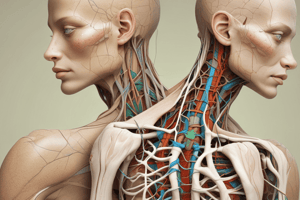Podcast
Questions and Answers
What is the primary purpose of auscultation during a clinical examination?
What is the primary purpose of auscultation during a clinical examination?
To listen to internal body sounds.
When should a nurse palpate tender areas during an examination?
When should a nurse palpate tender areas during an examination?
Tender areas should be palpated last to avoid causing pain.
Which percussion technique is best suited for assessing internal organ conditions?
Which percussion technique is best suited for assessing internal organ conditions?
Deep percussion.
What instrument is primarily used for inspecting the inner aspect of the eye?
What instrument is primarily used for inspecting the inner aspect of the eye?
Describe the technique used to feel for surface abnormalities.
Describe the technique used to feel for surface abnormalities.
What is the primary goal of palpation during a clinical examination?
What is the primary goal of palpation during a clinical examination?
What is the primary purpose of auscultation in a clinical examination?
What is the primary purpose of auscultation in a clinical examination?
Describe the proper technique for light palpation of the skin.
Describe the proper technique for light palpation of the skin.
Explain the importance of maintaining hygiene and proper hand care before palpation.
Explain the importance of maintaining hygiene and proper hand care before palpation.
What is the difference between light palpation and deep percussion in clinical assessments?
What is the difference between light palpation and deep percussion in clinical assessments?
What should a clinician observe in a patient during indirect percussion?
What should a clinician observe in a patient during indirect percussion?
Explain why CT scanning is not typically used during a manual clinical examination.
Explain why CT scanning is not typically used during a manual clinical examination.
What technique is employed during a clinical examination to assess heart sounds?
What technique is employed during a clinical examination to assess heart sounds?
Identify the type of pressure used during light palpation of the skin.
Identify the type of pressure used during light palpation of the skin.
What is the primary cause of ineffective auscultation when using the bell of a stethoscope?
What is the primary cause of ineffective auscultation when using the bell of a stethoscope?
What is the primary purpose of the inspection method in a physical assessment?
What is the primary purpose of the inspection method in a physical assessment?
Before performing palpation, what should a nurse do to ensure proper hygiene?
Before performing palpation, what should a nurse do to ensure proper hygiene?
Why is it important to use different degrees of pressure during palpation?
Why is it important to use different degrees of pressure during palpation?
What auscultation technique can enhance the ability to hear distinct heart sounds?
What auscultation technique can enhance the ability to hear distinct heart sounds?
Describe the technique of percussion in a clinical assessment context.
Describe the technique of percussion in a clinical assessment context.
What might happen if palpation begins with tender areas?
What might happen if palpation begins with tender areas?
What is the consequence of using specialized instruments during palpation?
What is the consequence of using specialized instruments during palpation?
Flashcards are hidden until you start studying
Study Notes
Clinical Examination Techniques
-
Hygiene and Hand Care: Essential for nurses to maintain personal hygiene and hand care before conducting palpation.
-
Light Palpation: Specifically used to detect surface abnormalities in the body.
-
Ophthalmoscope: The instrument designated for inspecting the inner aspect of the eye.
Palpation Protocol
- Assessment Order: Tender areas should be palpated last to reduce discomfort for the patient during a clinical examination.
Auscultation Purpose
- Primary Goal: Focuses on listening to internal body sounds to identify potential abnormalities.
Percussion Techniques
- Deep Percussion: Utilized to assess the condition of internal organs effectively.
Purpose of Clinical Techniques
- Palpation: Involves tapping directly and quickly over specific points of interest for assessment.
Auscultation Best Practices
- Avoiding Errors: Using the bell too firmly against the skin is discouraged, as it can obscure low-pitched sounds necessary for accurate heart sound auscultation.
Inspection Goals
- Visual Assessment: Aims to evaluate the patient’s external appearance and symmetry through observation.
Palpation Specifics
- Pressure Variation: Requires different degrees of pressure depending on body areas being assessed for a thorough examination.
Pre-Palpation Steps
- Hand Hygiene: Wash hands and ensure fingernails are short before performing palpation to minimize risk.
Indirect Percussion Observations
- Patient Monitoring: It is important to observe for signs of discomfort or pain in patients during the process of indirect percussion.
Clinical Exam Limitations
- CT Scanning: Not a manual examination technique; intended for diagnostic imaging rather than direct assessment in clinical exams.
Light Palpation Characteristics
- Technique Requirements: Involves applying only the lightest touch to inspect the skin and underlying structures during an examination.
Studying That Suits You
Use AI to generate personalized quizzes and flashcards to suit your learning preferences.




